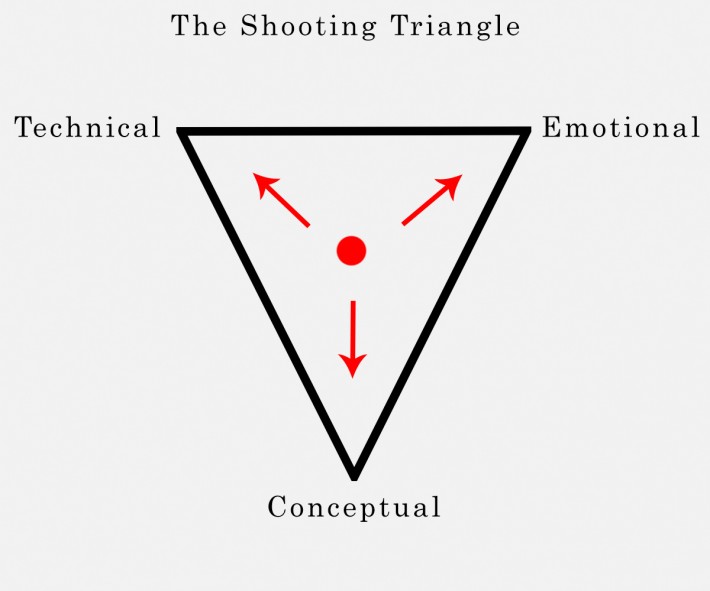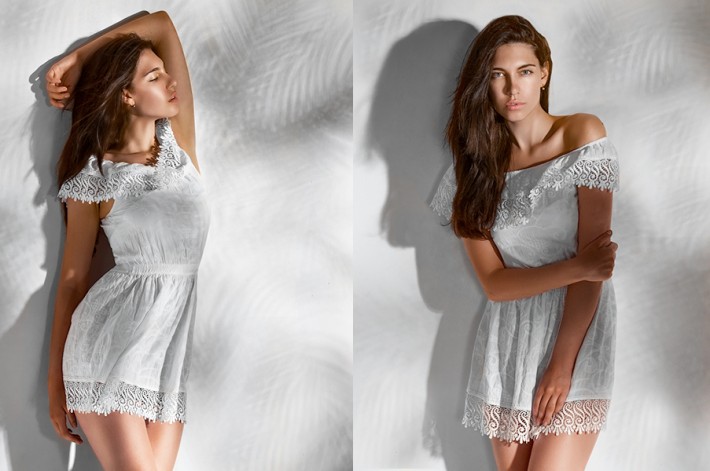One of the biggest frustrations I had when starting out photography was striking a good balance between all the aspects that went into creating a good image. I needed a system that helped me visualize the factors at play so that I could fully understand their impact on the work I was doing. So I developed something I call the shooting triangle to help myself understand all the facets that go into creating a good image. It is a system that works for me and maybe it can help you too.
I believe all good photographs are a combination and balance of three distinct aspects. When shooting I try and work within this triangle and I add or take away from each point as needed to create what I deem to be a perfectly balanced image.

Technical
The technical portion of the shooting triangle is where most photographers tend to place their focus. This is where you will choose the aperture, shutter speed, and iso for your camera based on the kind of work you are doing. You will also be deciding what lenses to pair your camera with for a given project. If you are shooting sports or wildlife you may not want to show up with a wide angle prime, just as shooting architecture might not lend itself to only bringing a telephoto lens. This is also where you will decide what lighting you intend to use and how you intend to use it. You can opt for natural light, continuous, or perhaps you will bring out the strobes. If you use artificial light you will further need to decide the kind of light you want to create and the modifiers that will give you the light you are looking for.
In addition to your camera and light settings, there are other technical considerations to keep in mind here. Some projects will require specialty equipment all of which needs to be accounted and planned for. Maybe you want to use cookies on set to create interesting patterns with your lighting. Maybe you will choose to use a projector. Maybe you need a rain or snow machine. Perhaps you are shooting under water and require waterproof casings for your equipment.
Whatever the case may be, the technical portion of the shooting triangle is all about UNDERSTANDING your equipment and making it work for you to achieve the results you are after. Understand the equipment but do not let it control you.
The trap many photographers fall into is that they spend most of their time obsessing over the technical aspect of photography. While it is a good thing to educate yourself about your equipment and to become proficient with it, it can actually be quite detrimental if you rely too heavily on it. This is where we can run into issues of gear lust. Some photographers will become convinced that in order to capture better photographs they will need better and newer equipment.
Furthermore, by focusing too much on the technical aspect of photography you can become so consumed with thinking about the composition, exposure, and focus in your photographs that you will overlook the other critical parts of capturing a good image. There is so much more to a good image than perfect composition, exposure, and focus.
Conceptual

The conceptual portion of the shooting triangle is probably the least practiced by new photographers and something I personally struggled with for many years. I am by nature a very spontaneous personality and I think that translates a lot into my photographic style. I can still recall a time when I would show up to a project without a plan. I was convinced that I could make magic happen on the spot. What I quickly learned was that this made my job FAR more difficult than it needed to be.
The conceptual portion of the shooting triangle is all about pre-planning your photoshoot so that you walk in prepared. This does not mean that you can not deviate from your plans and that you lose all spontaneity on set. There is always room to make changes the day of but forcing yourself to come up with ideas on the spot usually ends up with weak concepts that have clearly not been fully formed and thought through.
Whenever I have looked at good images I have often thought to myself: what a beautiful model, what a beautiful location, what great styling, etc. The longer I have been doing this the more I realize those things rarely just happen. The universe does not magically align on every photoshoot to give you all the outfits, talent, and props at your disposal the day of. These are all things that need to be planned out ahead of time.
As with the other points in the triangle your focus can not be completely consumed by the concept. While the location, styling, talent, and props can all help create an environment and add much needed polish to your images, if you don't have the technical or emotional balance to back it up, your photographs can fall flat and the message can get lost in a sea of clutter.
Emotional

The emotional portion of the shooting triangle is the hardest to nail for photographers. Many of us try to capture a moment, tell a story, or convey a message through our images. We can spend hours, days, or even weeks developing a concept. We can plan out all of our equipment for the project and know it like the back of our hand. We can get perfect exposure, tack sharp focus, and follow every rule in the handbook. Even with all that our images can fall completely flat if they lack the emotional connection.
Emotion in your images can come in many forms. It can be a facial expression or a pose. It can be the juxtaposition of elements. Or it can be as simple as a color palette. Part of being a great photographer is learning how to be a good director. You need to be in control of your images and you need to learn how to fuel them with emotion and set the mood.
I am a big believer in studying human dynamics and social interaction as a supplement to all your photographic skills. I believe that it is critical to know how to influence your subjects emotional state and coax what you need out of them. When I work with models I always make it a point to build rapport before we get to any shooting. Before I can get them into ANY emotional state I need to get them comfortable and relaxed. I've actually had models tell me after our photoshoots how incredibly comfortable they felt throughout the process. If you strive for that mental state you can get incredible range and emotional response from your subjects. When it comes to human subjects, posing is also extremely important, but without the proper state of mind even a good pose can look uncomfortable and forced.
If you balance the emotional response from your subjects with the technical abilities you possess and combine that with a solid concept, you will be well on your way to creating what many viewers will deem to be good photographs.
The Great Compromise
While I believe that a good photographer should strive to balance all three of these points as best as they can, sometimes sacrifices need to be made in order to capture the right frame. In street or wedding photography you may encounter a variety of quickly changing light conditions that require you to compromise the technical portion of your shooting triangle just so that you can nail the emotional aspect of the image. Likewise, when shooting catalog, you may fore-go some emotion in order to create a technically superior image.
If you understand and employ the shooting triangle you will quickly come to find where your weaknesses lie and you can begin to push and pull your strengths and weaknesses as needed within the triangle to create a perfectly balanced photo that hits all points, and ultimately, entrances the viewer.







Interesting.
Lots of wisdom here ! Thanks for sharing !
You are welcome. :)
One of the more insightful articles on Fstoppers lately.
Why thank you!
Fascinating indeed. :) well done, Sir.
Cheers!
Great article that i definitely can relate to. i'm learning photography and i still struggle with getting the right balance between this 3 parameters. I tend to get too conceptual and disregard everything else. Getting the right balance between your concept and a good execution of that same concept, while getting some emotional response from others is a true pain in the neck
Practice makes perfect. Keep at it!
Good points. I love to plan, so I'm glad to hear you say, "The universe does not magically align on every photoshoot to give you
all the outfits, talent, and props at your disposal the day of."
I wish I had a bit of your love for planning haha. :)
Meh! Triangles make me think about high school geometry not photography. If I am going to think about any shape while shooting it is the hour glass.
Cartier-Bresson was quoted as saying that geometry was the foundation of a great photograph.
I found this to be extremely true. I came up with my own 'shoot list' of things I have to hit each time to get a successful picture and it mimics this, definitely a good thing to keep in mind!
Great article Peter, really liked the simplicity and relevancy of this piece!
Thanks Dave!
This article is a great read and came at a perfect time for me. Thanks Peter.
You are very welcome!